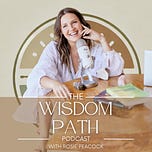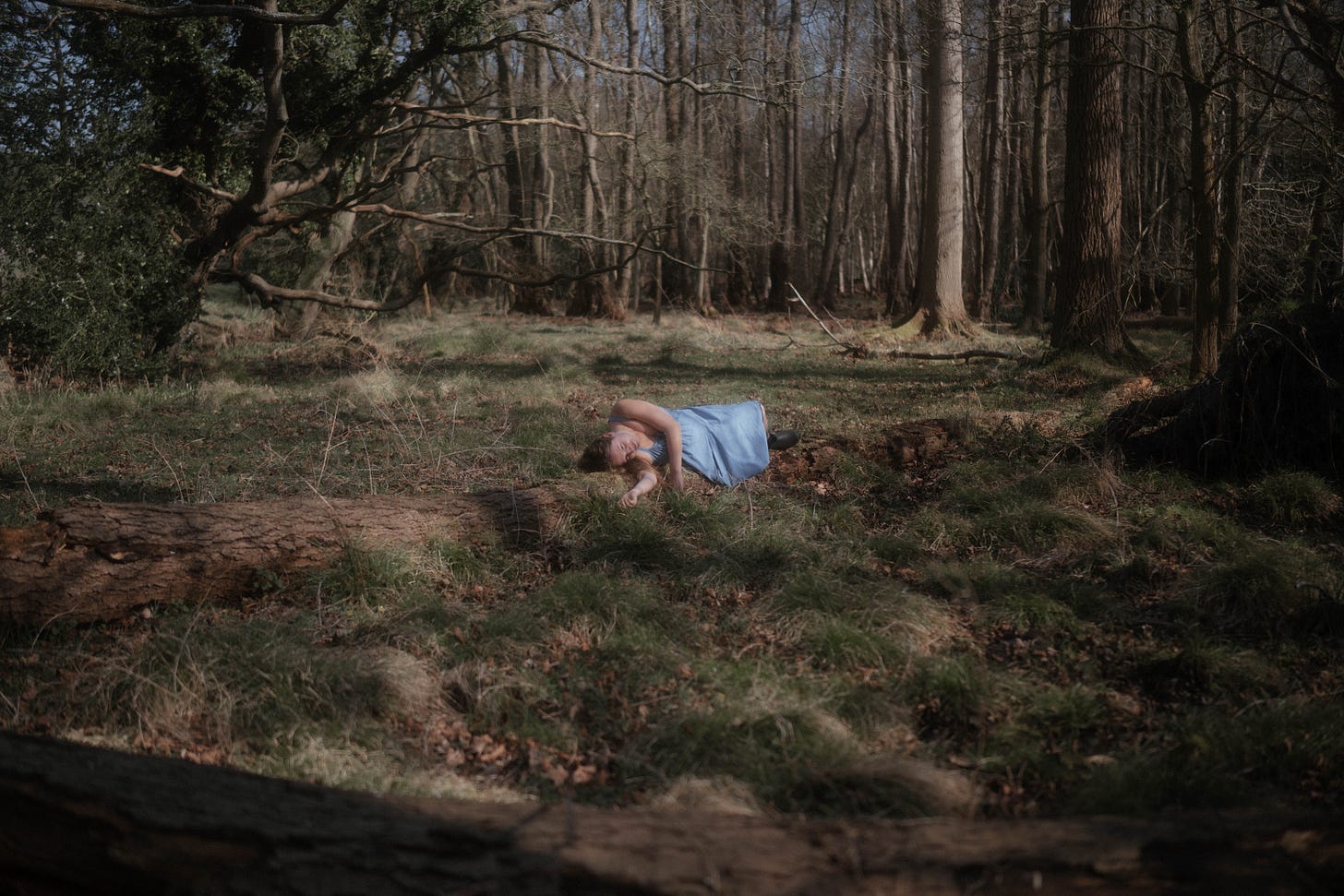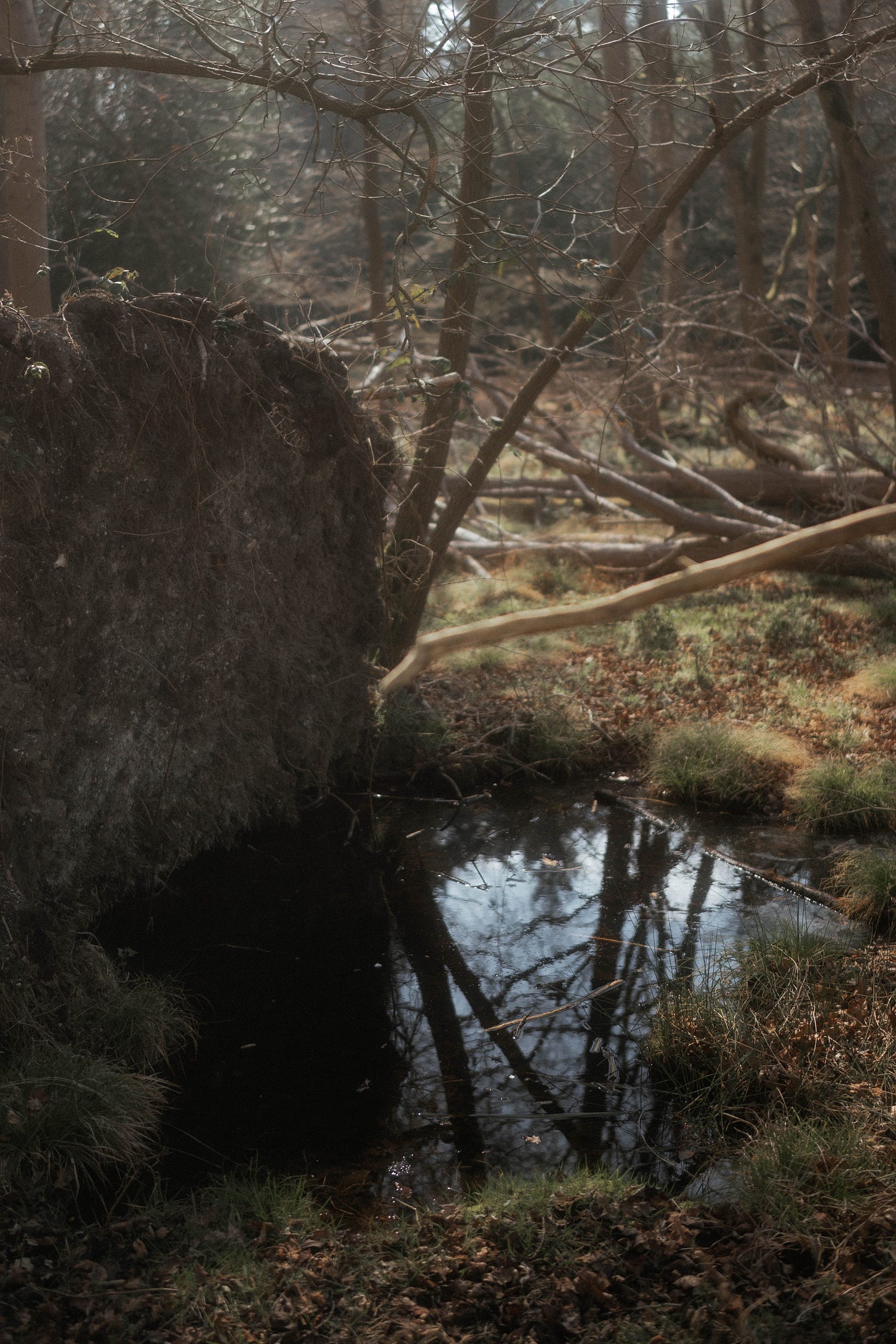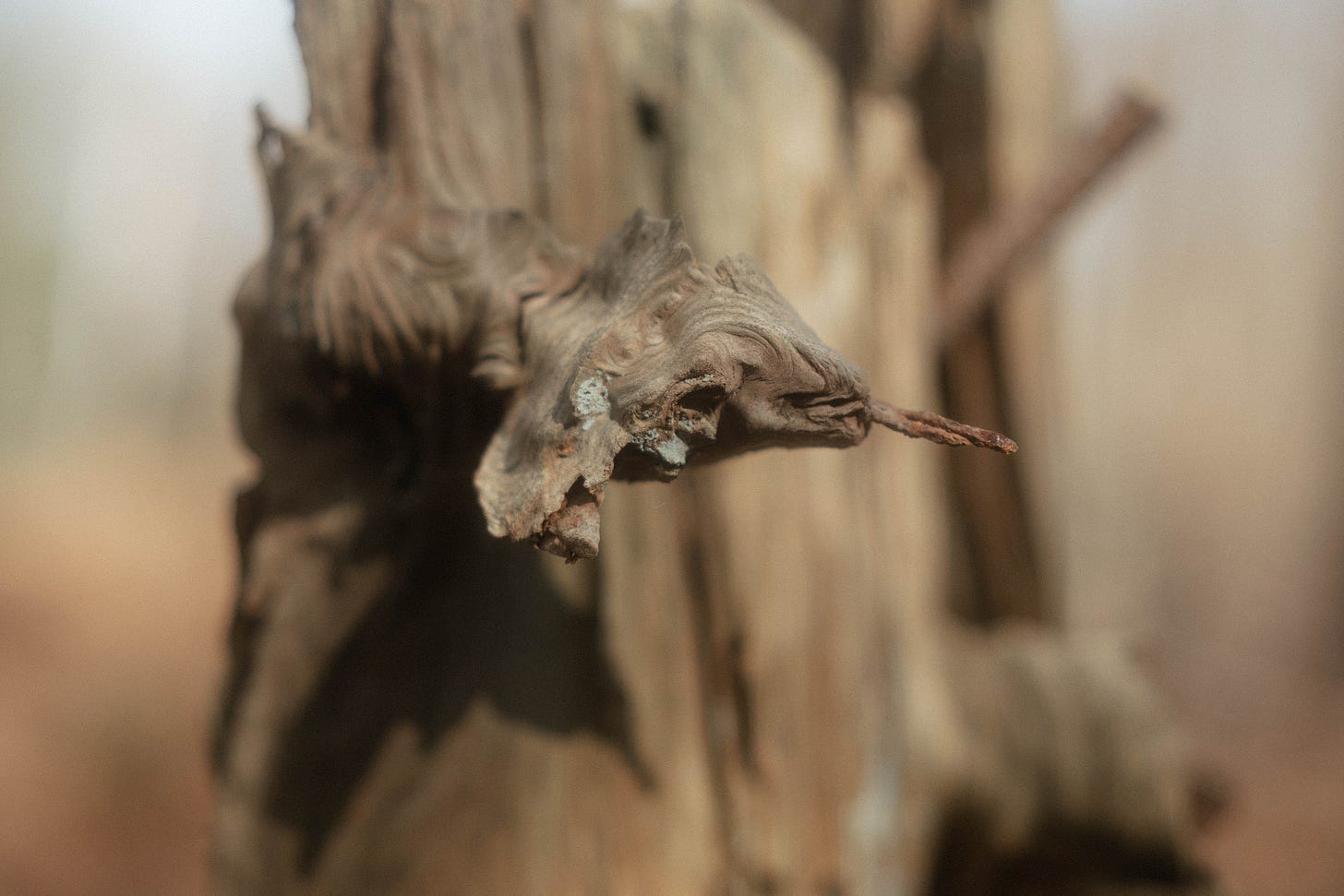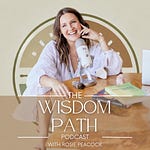Hello my loves,
I’m tuning in with you today from the soft, mossy depths of Blickling Woods, an ancient, lovingly kept woodland held by the National Trust here in the UK. As I record this, I’m surrounded by the gentle rustle of branches and the symphony of birdsong, which I hope you can hear softly in the background. It felt important not to block out the soundscape today, because in many ways, this setting embodies the very essence of what we’re talking about: a return to presence. A reconnection with the living world. A coming home to the body.
This is one of our unscripted, off the cuff little microdose episodes, a free-flowing exploration from the heart. And today, we’re diving into a theme that’s been a lifelong path for me: embodiment.
This journey of coming back to my body, again and again, has been the undercurrent of so much of my personal, spiritual, and creative work. It’s not a linear journey. It’s a spiral. A remembering and forgetting. A soft returning.
So what is embodiment, really?
To me, it’s the experience of being in deep dialogue with your body. Not just being aware that you have a body—but feeling it, inhabiting it, letting it speak to you and through you. It’s about cultivating such an intimate relationship with your own physicality that your body becomes an oracle of truth. A compass. A source of knowing far deeper than logic alone.
There are two layers of embodiment I want to speak to here.
First, there is the somatic body, the sensations, the breath, the tightness in your shoulders, the soft ache of your belly, the way your skin responds to sunlight. This is the physical, sensory aspect of embodiment. It’s how you feel your way through life, rather than think your way through it.
Then there is embodied wisdom, the lived integration of what you know. It’s the moment when something you’ve learned no longer sits only in your mind, but begins to shape how you move through the world. Embodied wisdom isn’t just about what you know. It’s about what you live. What you practice. What you become.
We can spend years reading spiritual texts, listening to personal development podcasts, following inspiring teachers. But if we don’t allow those insights to root down into our bones, to ripple out through our choices, our language, our relationships, then what are we really doing?
We’re gathering knowledge, not growing wisdom.
The Problem with Consuming Without Integrating
We live in a time where it’s so easy to consume and so easy to distract. A world where the next book, the next course, the next ceremony is always within reach. But I’ve come to realise that one of the deepest practices of embodiment is pausing long enough to ask:
Have I actually integrated what I already know?
Because true embodiment isn’t about endlessly reaching for more. It’s about letting what you’ve already received change you.
It reminds me of how people sometimes move from one psychedelic ceremony to another without giving themselves space to integrate. The wisdom that comes through those altered states is rich and powerful, but it’s nothing without embodiment. If you don’t take the time to live what the medicine showed you, the transformation never fully lands.
The same goes for everyday insights, whether they come from a podcast, a conversation, a poem, or a quiet moment in nature. Do you allow yourself to absorb and apply what resonates? Or are you chasing the next high, the next piece of information, the next hit of inspiration?
We’re not designed to be information-gathering machines. We’re meant to be living expressions of the truths we carry.
Recognising Disconnection in the Body
One of the first places I personally notice disembodiment is in my relationship with food and movement. These are my earliest indicators that something is off within me, that I’m not fully in tune with my own needs. When I’m present and aligned, I tend to eat foods that are vibrant and nourishing, fruits, vegetables, things that feel alive with vitality. I intuitively balance what I eat with the kind of movement I’m doing, and it all flows from a place of care and awareness.
But when I’m disconnected, when I’m slipping into old patterns of overworking or overstimulation, that attunement fades. I might eat mindlessly, reach for quick fixes, or avoid movement altogether. I start ignoring the cues of my body. And it’s not because I don’t care. It’s because I’ve slipped into a culturally acceptable form of disassociation.
Work is one of the most socially sanctioned places to hide. When I’m deep in editing a client gallery or on a long shoot day, I can easily drop into flow state. And flow, in itself, is a beautiful thing. But when I start chasing that flow in order to avoid sitting with my body, it becomes a subtle form of running from myself. I might not even realise I’m doing it until I’m overtired, overwhelmed, and wondering why I feel so far from home within myself.
Disembodiment often looks like this. It looks like functioning, even thriving, on the surface, while something within you is quietly calling out to be felt, to be heard, to be witnessed. And we all have our versions of this. Some people run from themselves through work. Others through relationships, technology, busyness, or numbing behaviours. The form doesn’t matter as much as the awareness that it’s happening.
Embodiment, for me, begins with noticing that I’ve left, and then choosing to come back.
Practicing the Return
So how do we begin to return to ourselves?
For me, reflection is the first step. Journaling often helps, offering me a mirror to see what’s happening beneath the surface. Even speaking into this microphone, as I walk here through the woods, feels like a form of self-reflection. It’s a way of tuning in and listening, of naming what I’m feeling and noticing what’s alive in me.
Sometimes I’ll speak with a therapist or a coach. And in those moments when those resources aren’t accessible, I’ll even have reflective conversations with AI. I’ve found that when used intentionally, even technology can offer a mirror. The key is to be clear that you’re not outsourcing your truth, but rather using the tool to help reflect your own wisdom back to you. You have to train it to offer rounded perspectives, not regurgitate answers. It’s not the oracle. You are.
And sometimes, the return to the body is as simple as pausing to feel.
Right now, as you’re reading, I invite you to bring your awareness to your body. What sensations are present? Is there a tightness in your jaw or softness in your belly? Are there any tingles, aches, or waves of pleasure moving through you? How often do you pause during the day to check in with these somatic cues?
The body doesn’t lie. It is constantly speaking in sensation. And when we learn to listen, those sensations become a map. They tell us when something is aligned and when something is not. They guide us toward what is nourishing and away from what is depleting.
You know this already. Think about a moment when you were asked to do something you didn’t want to do. Did your shoulders tense? Did your stomach twist? That’s your body saying no. Or maybe you were invited into something that felt expansive and exciting, and your whole being lit up. That rush of energy, that grounded certainty in your gut or womb or chest, that is your body’s yes.
Your body is a dowsing rod for truth. But you have to be willing to slow down enough to feel it.
Embodiment as Alignment
Once we begin listening, once we start dropping into our somatic experiences with consistency, we create the conditions for deeper alignment. Embodiment becomes the bridge between knowing and doing, between belief and behaviour. And when that alignment is present, something inside of us settles. We begin to feel whole.
I often imagine it like a Venn diagram. On one side, who you are. On the other, who you want to be. As you move deeper into embodiment, those circles begin to overlap more and more. There’s less inner conflict. Less pretending. More congruence.
And that congruence, that embodied alignment, is what leads to a deeper sense of wellbeing. Not just the fleeting happiness that comes from a good moment or a joyful event, but something much more profound.
When we live in alignment with what we know to be true, what we feel in our bones, our gut, our womb, we enter into a state of eudaemonia. It’s a term from ancient Greek philosophy that refers to a deep, sustained satisfaction with life. A feeling that life is meaningful, purposeful, and headed in the right direction.
It’s not about chasing pleasure or staying constantly happy. That would be hedonic, the hedonic treadmill we often find ourselves on, where we’re always looking for the next hit of dopamine. But eudaemonia is deeper. It’s soul-satisfaction. It’s that quiet sense of rightness in your life that doesn’t waver with every external event.
And embodiment is the gateway.
When we choose to live in alignment with our values, our inner knowing, and the truths we’ve already learned, we begin to live the life we’re here to live. We stop performing, and we start being. We stop chasing something outside ourselves, and we begin rooting into something already within.
That is the power of embodiment.
Choosing to Live What You Know
Have you ever met someone and you look at them and they just practice what they preach and the way it feels to be in the energy of somebody who is so congruent, who is so embodied, who just is truly a reflection of their understanding of the world? I’ve met some rare people who are either deeply on their spiritual path or are very deeply expressed in a creative artistic way, who are completely 100% embodied in this sense, and it feels incredible to even be around them. The art that they can create or the things that they are able to do.
There was a man who wrote a phenomenal book, Yoga and The Dark Night of The Soul, his name is Simon Haas. And when I met him in person, it’s like the light of his soul shone from behind his eyes. I could tell in everything he did and said that he did his spiritual practice with such rigour, and we’re talking not just like the getting on the yoga and doing the postures. I’m talking he lived the Yamas and the Niyamas, the codes of life. He understood the Bhagavad Gita and its teaching so deeply and applied it to every area of his life that his life was lived with spiritual wisdom.
One of the most powerful ways we embody wisdom is through the choices we make each day. The small, seemingly mundane decisions become sacred when we make them from a place of deep connection with ourselves. Things like whether to go for a walk, to nourish our body, to pause instead of push, to rest when our system asks for it. These aren’t just lifestyle habits. They are invitations to live in alignment.
When I feel that subtle pull away from myself, I try to pause and ask: What would the most integrated version of me choose right now? What would the wisest version of me do? Sometimes I imagine myself as an elder looking back on my life with clarity and compassion. Other times I think about what I would want for my child. Would I want them to push through exhaustion or choose gentleness? Would I want them to override their body’s signals or honour them?
This lens often helps me see more clearly. It pulls me out of my head and into a space of inner parenting, a space of love. Because the truth is, every part of us wants what is best for us. Every cell in the body is designed for life, for healing, for thriving. Our mind can sometimes be the last one to catch up.
We forget that we are not just here to perform or produce. We are here to feel, to live, to express. And when we start making our daily choices from that deeper wisdom within, life begins to feel different. More alive. More rooted. More real.
The Feminine Path of Descent
For centuries, much of the dominant spiritual narrative has been one of ascension. Rising up and out of the body. Transcending the flesh. Moving from the base of the spine into the higher realms of consciousness and beyond. This path is valid and beautiful in its own way, but it has often come at the expense of the body, especially the feminine body.
For me, the sacred path is not one of escape. It is a path of descent. It is about coming deeper into the body, not leaving it behind. It is about remembering that we are already spiritual beings, already connected, already divine. And that the body is not an obstacle to enlightenment but a portal into it.
This is especially true for women and those who walk a cyclical path. Our bodies are inherently sacred. Through our wombs, our cycles, our sensuality, and our connection to the earth, we are constantly invited into a living spirituality. Motherhood, menstruation, creative expression, and pleasure are not distractions from the path. They are the path.
Embodiment, in this context, becomes an act of reclamation. Reclaiming our right to feel good in our bodies. Reclaiming our sensuality, our desires, our softness and our wildness. Reclaiming the wisdom that lives in our wombs, in our hips, in our breasts, in our blood. This is the descent into gnosis. Not intellectual knowledge, but the deep, lived knowing of the goddess within.
The Body as a Spiritual Practice
So much of my spiritual practice now is rooted in this descent. It is about coming home to the part of me that already knows. Not learning more, not doing more, but allowing what is already true to rise up through my body and shape my life.
Embodiment has become the place where all the threads of my work meet. Whether I am holding space in ceremony, capturing someone’s essence through the lens of my camera, or guiding a client through a personal brand journey, the thread is the same. It is about congruence. It is about alignment. It is about supporting people to feel and express the truth of who they are through their body.
My photoshoots are embodiment photo shoots. They’re about coming into the body and capturing that felt experience, not just what it looks like on the external. And whether that’s embodied love through somebody’s wedding, whether that’s embodiment in somebody’s brand, or whether that’s embodiment as portraiture, where people want to embody a deeper connection with themselves, the work that I get to do is all about having a deeper sense of this. First of all, congruence, embodied wisdom, and also a deeper sense of the somatic experience of our bodies.
This, for me, is the heart of ‘the work’. And it is why embodiment is not just something I talk about, but something I live. Or more honestly, something I return to, again and again.
Remembering and Forgetting
This practice of embodiment is not about perfection. It is not about arriving at a state where we are always present, always aware, always aligned. That would be impossible. We are not machines. We are living, breathing, cyclical beings. And the journey of embodiment is not linear. It is a spiral. One of remembering and forgetting, remembering and forgetting, again and again.
I first learned this deeply when I began meditating many years ago. Back when I was working as a secondary school teacher in the UK, overwhelmed by the endless demands of the system, I found myself clinging to a mindfulness course like a lifeline. I remember walking into it with the belief that I was terrible at meditation. That I couldn’t do it. That my mind was too busy. That I was somehow failing.
But what I learned changed everything. The practice of meditation is not about staying with the breath forever. It is about noticing when you’ve forgotten, and gently coming back. Over and over. The moment of return is not a failure. It is the practice itself.
You might sit with your breath for a few seconds, then find your mind wandering to what’s for dinner, or what time to pick up your child, or what that person said to you yesterday. And then, suddenly, you remember. You catch yourself. You come back. And that moment, that return, is a moment of awakening. That is the work. Not never forgetting, but remembering how to come back kindly.
This is how I live my life now. As a continual coming home. A continual soft return to the body, to my truth, to the wisdom within me. Each time I find myself outsourcing my knowing, each time I catch myself seeking validation, asking someone else to tell me what I already know, I pause. I breathe. I return.
Trusting Your Inner Wisdom
It can be tempting to keep seeking outside ourselves. To ask a coach or a mentor or even AI what to do next. And sometimes, those reflections can be useful. But only when we are rooted in the knowing that the deepest guidance already lives within us. No one else can give us our truth. At best, they can help us hear it more clearly.
So often, forgetting looks like this. Outsourcing our power. Doubting our creativity. Asking for permission instead of listening to the part of us that already knows. The part of us that is already wise. Already whole. Already ready.
When we remember, when we drop back in, when we return to our bodies, we make decisions not from urgency or fear, but from clarity. We move not to prove something, but because it feels right. And we begin to live, not from habit, but from intention.
This is why embodiment is not just a concept or a tool. It is a spiritual path. It is a devotion. It is a remembering of the divine spark within each of us. A remembering that we are not here to be like anyone else. We are here to be ourselves. Fully. Fiercely. Freely.
A Path Forward
And so, I end this microdose reflection where it began. In the woods. In the body. In the breath.
I came here to the beautiful woods on this sunny day instead of diving into more client edits today because I needed to remember. I needed to hear the birds. To feel the gentle breeze on my face. To walk until I could find myself again. And as I walked, I felt myself return to the core of who I am. That quiet place within that always knows. That always waits for me. That never judges the forgetting.
This is the path. The Wisdom Path. A spiral path. A lived path. A path of returning. And each time we remember, we get to embody our truth a little more deeply. We get to show up with more clarity, more resonance, more grace. We get to live our wisdom, not just speak it.
Thank you for walking with me today. Thank you for listening, for reading, for meeting yourself in these words. If this has resonated, please share it. Leave a review. Comment. Help it reach the ears and hearts that need it. This work is given freely, and your support helps it find its way home.
Until next time, may you remember the wisdom that lives in your body. May you return to it often. And may you walk your own spiral path with courage, softness, and truth.
In creativity and connection,
Rosie 🦚


